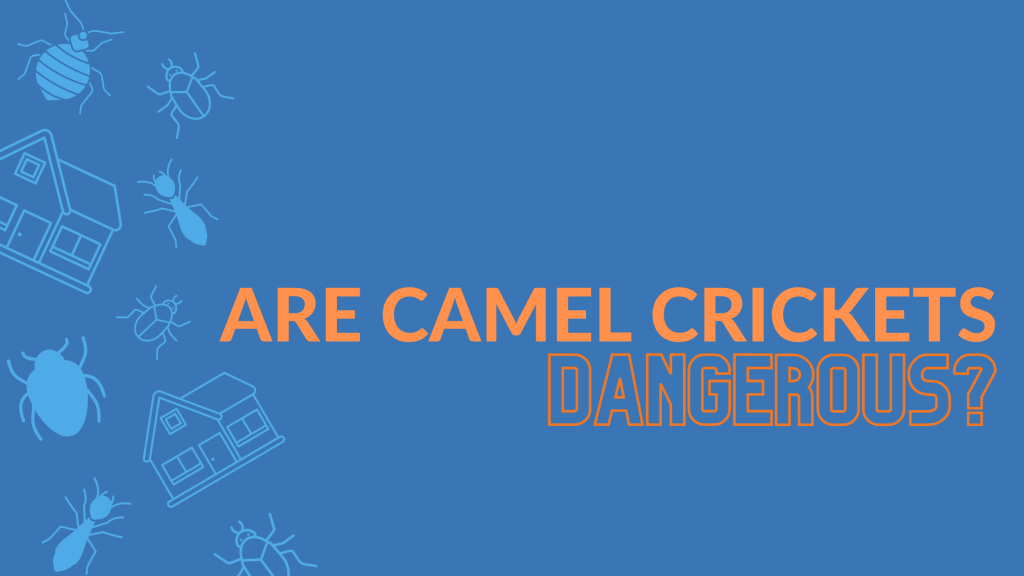Are camel crickets dangerous to humans?

Are camel crickets dangerous to humans?
They look like a cross between a spider and a cricket. They mainly appear at night and you certainly don’t want them in your home. But what’s the real deal with these little bugs? Are camel crickets dangerous to humans? Find out more below!
A cricket by many names
Camel crickets (AKA spider crickets AKA sprickets) resemble large spiders. Just like spiders, they appear mainly at night and enjoy dwelling in dark, damp cave-like places, like garages and basements. As one of their names suggests, they look like an odd cross between a cricket and a spider. They’re a light tan and brown color, about 1-1 ¼” long, and unlike other crickets, they don’t have wings (so good news is – they don’t fly!). Camel crickets are related to cave crickets and live throughout a lot of the U.S.
Why do camel crickets look so creepy?
One of the reasons that scares a lot of homeowners when they first encounter a camel cricket is that they look… well, creepy. In the dark, especially, these little guys resemble large spiders – not something many people are excited to see. Camel crickets have 6 very long legs, a curved hump back (hence the name “camel” cricket), and their odd drumstick shaped hind legs make them incredibly good at jumping. A little too good if you’re an unsuspecting homeowner. Camel crickets don’t have very good eyesight (they stem from cave crickets, which are a species that survives in pitch black, 24/7). Because of these, they rely on their jumping to respond to threats. Unfortunately, their go to tactic is to leap towards the thing that they’re afraid of, in order to intimidate it and scare it away. It’s especially effective, especially against humans.
Do camel crickets bite?
Pouncing spider crickets sounds terrifying enough but are they harmful or likely to bite once they leap? While they look like spiders, they’re still harmless little crickets. They don’t have fangs or the ability to bite.
That being said, they are omnivores and will eat fungus, plants, other insects, and even fabric. While they’re not dangerous to you directly, they’re definitely a threat against your favorite cotton sweater.
Do camel spiders make noise?
Unlike house crickets, camel spiders don’t have the ability to make sound. This is good news if you find them invading your home.
What do camel crickets do?
Camel crickets are generally considered household pests since they like to gnaw on house plants, clothing, fabric, and other items in basements and garages. In the winter, when it’s cold, they tend to huddle together, which can increase the likelihood of damage to your belongings.
Help! I have camel crickets in my house, what do I do to get them out??
As mentioned, camel crickets aren’t an immediate threat to humans. They are however a nuisance. They will eat just about anything and in large numbers, their feces can stain floors and walls. They’re also a good food source for mice, which could introduce other pests into your home. If you find yourself with a camel cricket infestation, don’t panic.
Here are a few things to do to get rid of your uninvited guests.
- Seal floors, windows, and doors – anywhere where they might be crawling in from outside
- Dry out areas where moisture accumulates – Place a dehumidifier in your basement or garage
- Shed some light – replace light bulbs as needed and get some light in your basement, garage, or crawl space for extended periods of time to deter crickets from seeking refuge
- Get rid of leaf litter – vegetation, fungus, and other food sources.
- Seal up clothing in storage in garages and basements in plastic containers
- Avoid stacking firewood near your home (also a good idea to keep termites away)
- Use cedar pouches and tea tree oil or citronella – all of which are all natural fungicides and insecticides
If all else fails, call in an experienced exterminator to help remove camel crickets.
